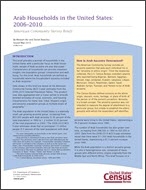
An official website of the United States government
Here’s how you know
Official websites use .gov
A .gov website belongs to an official government organization in the United States.
Secure .gov websites use HTTPS
A lock (
) or https:// means you’ve safely connected to the .gov website. Share sensitive information only on official, secure websites.
-
//
- Census.gov /
- Publications /
- Arab Households in the United States: 2006-2010
Arab Households in the United States: 2006-2010
Arab Households in the United States: 2006-2010
Introduction
This brief provides a portrait of households in the United States with a particular focus on Arab households; people of Arab ancestry are also discussed.1 Characteristics of households can provide important insights into population groups’ composition and well-being. For this brief, Arab households are defined as households where the householder’s ancestry included an Arab response.2
Data shown in this brief are based on the American Community Survey (ACS) 5-year estimates from the 2006–2010 Selected Population Tables. This product uses data aggregated over a 5-year period to provide detailed estimates of social, economic, and housing characteristics for many race, tribal, Hispanic origin, and ancestry population groups at multiple levels of geography.3
The Arab population in the United States is a relatively small, yet growing ancestry group, increasing from 850,000 people with Arab ancestry (0.35 percent of the total population) in 1990 to 1.2 million (0.42 percent of the total population) in 2000.4 The 2006–2010 ACS 5-year estimates show that an estimated 1.5 million people (0.5 percent of the total population) with Arab ancestry were living in the United States, representing a 76.0 percent increase since 1990.
The number of Arab households has also grown over time, increasing from 268,000 in 1990 to 427,000 in 2000. Data from the 2006–2010 ACS 5-year estimates reveal that there were 511,000 Arab households in the United States, representing a 91.0 percent increase since 1990.
While the Arab population is a distinct ancestry group, it is also a heterogeneous one, composed of many groups with different ethnic origins originally from the Middle East and North Africa. This brief focuses on a number of selected Arab ancestry groups—Lebanese, Egyptian, Syrian, Palestinian, Moroccan, Iraqi, Jordanian, and Yemeni.
The following sections highlight some of the different types of characteristics available in the Selected Population Tables for total households and households with an Arab householder, such as average household size, household type and composition, homeownership, and median household income.
__________
1 For more information on households in the United States, visit <www.census.gov/topics/families.html>.
2 Arab ancestry is determined if one or two Arab ancestries were reported. Two ancestries were collected from each individual and the order does not matter. For example, a householder reporting “Lebanese and Syrian” is included in the Lebanese as well as in the Syrian estimates, and a householder reporting “Lebanese and French” is included in the Lebanese and French estimates, but note only Arab ancestries are discussed in this brief. In addition, the U.S. Census Bureau tabulates responses of “Arab,” “Arabic,” “Kurd,” and “Berber” as Arab.
3 This brief features selected Arab ancestry groups with at least 5,000 Arab households in 2006–2010.
4 U.S. Census Bureau, decennial census, 1990 and 2000.
Others in Series
Publication
Publication
Publication
Share
Related Information
Some content on this site is available in several different electronic formats. Some of the files may require a plug-in or additional software to view.
 Yes
Yes
 No
NoComments or suggestions?


Top

